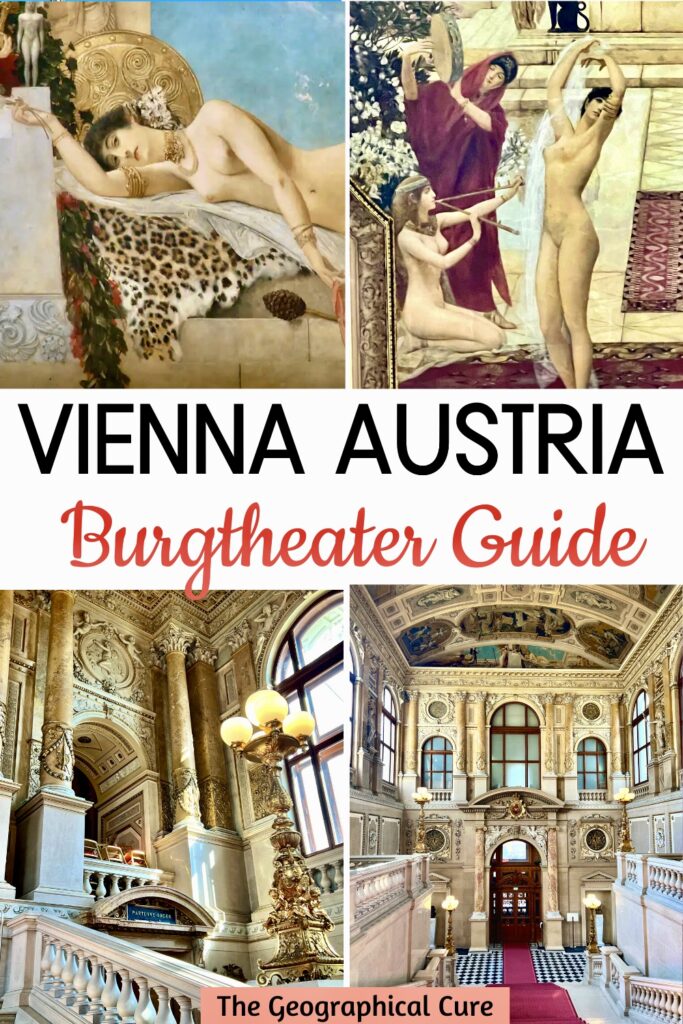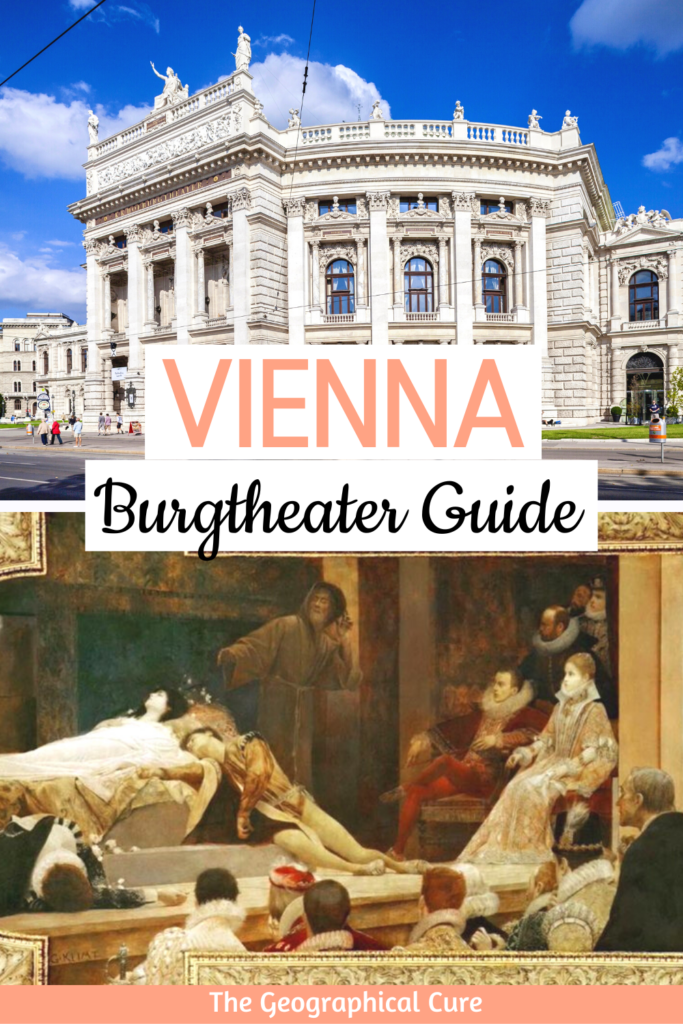The Burgtheater in Vienna is one of the largest and oldest theaters in the world. It’s certainly the most prestigious German-language theater.
Inaugurated in 1888, “die Burg,” as the Austrians call it, is housed in a beautiful Neo-Renaissance building. It’s a prime example of historicism architecture, with an imposing facade on the Ringstrasse.
Inside, the theater continues the pomp and circumstance. It boasts magnificent staircases, elaborate frescoes, and ornate statuary and decorations.
This is where three Mozart operas premiered and some of the greatest German and Austrian actors performed.
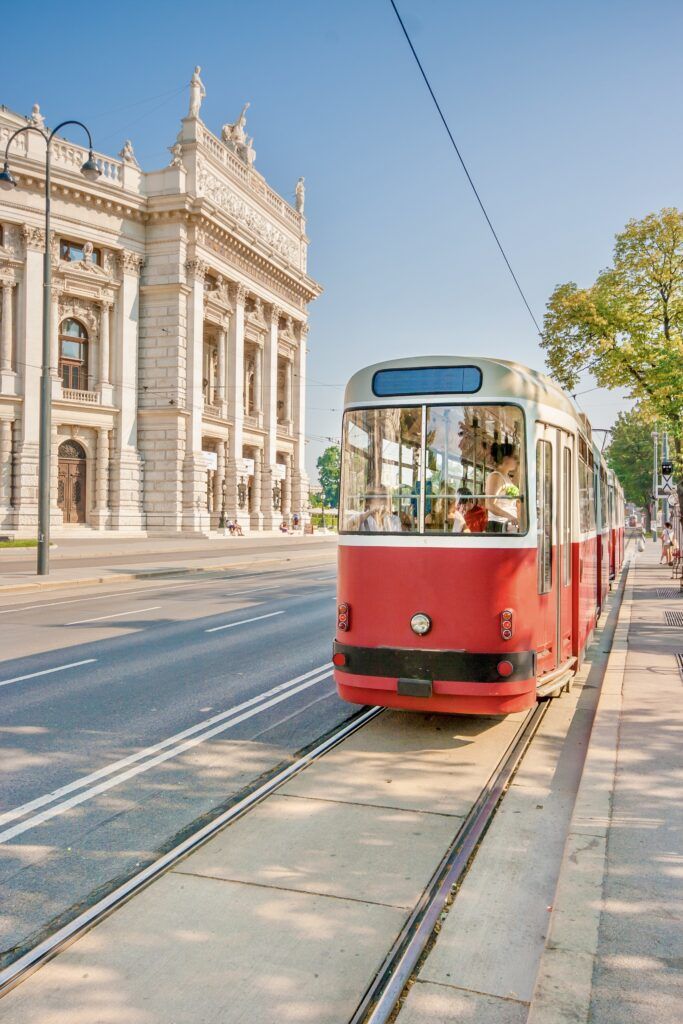
This is where you can see rare early works by Gustav Klimt, Austria’s most famous artist. If you’re on the Klimt trail in Vienna, the theater is a must visit!
Despite all that, most visitors to Vienna don’t go inside. Recently, I took a tour of the esteemed theater. And I’m happy to say it was totally worth an hour or so of my time.
Here’s a quick snapshot of what you can see at the Burgtheater,
- facade
- entrance halls
- grand staircases
- Klimt frescos
- Geiger’s grisaille paintings
- grand foyer
- auditorium/ stage
>>> Click here to book a Klimt tour of Vienna
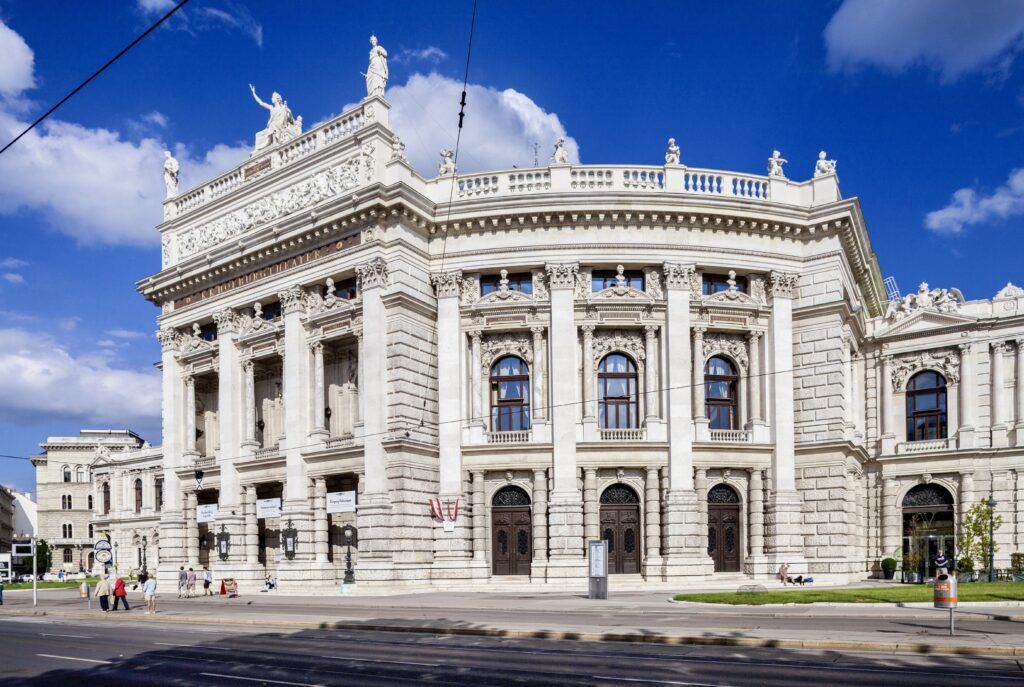
Guide To The Burgtheater: What To See
Facade
The Burgtheater was built between 1874 to 1888. It was designed in a Neo-Renaissance style by renowned architects Gottfried Semper and Karl Hasenauer.
The Burg was destroyed in air raid in 1945 in WWII. But it was meticulously rebuilt to its original splendor in 1953-55.
The imposing front facade is semi-circular, with two level of arched windows and a grand portal with Corinthian columns. It has a beautiful proportion and symmetry, from the use of classical elements such as columns, pilasters, and pediments.
The sculptures on top of the Burgtheater in Vienna are allegorical representations of the arts. At the tip top, of the attic, in the center, is a seated Apollo. He’s crowned with a laurel wreath and holds a lyre.
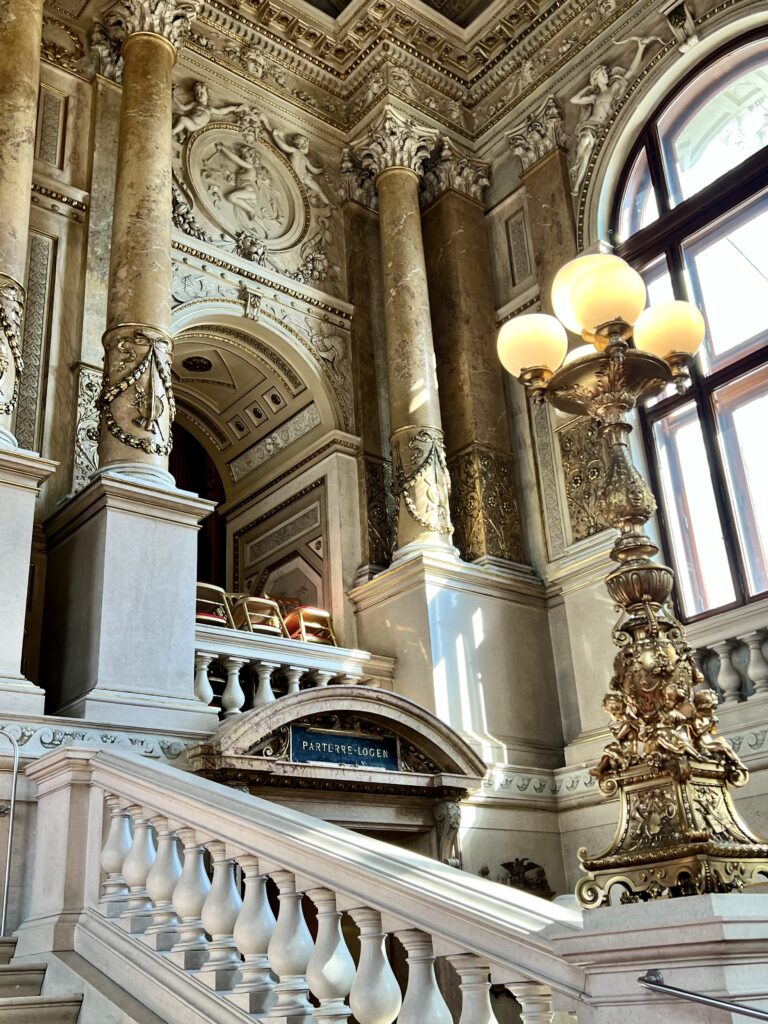
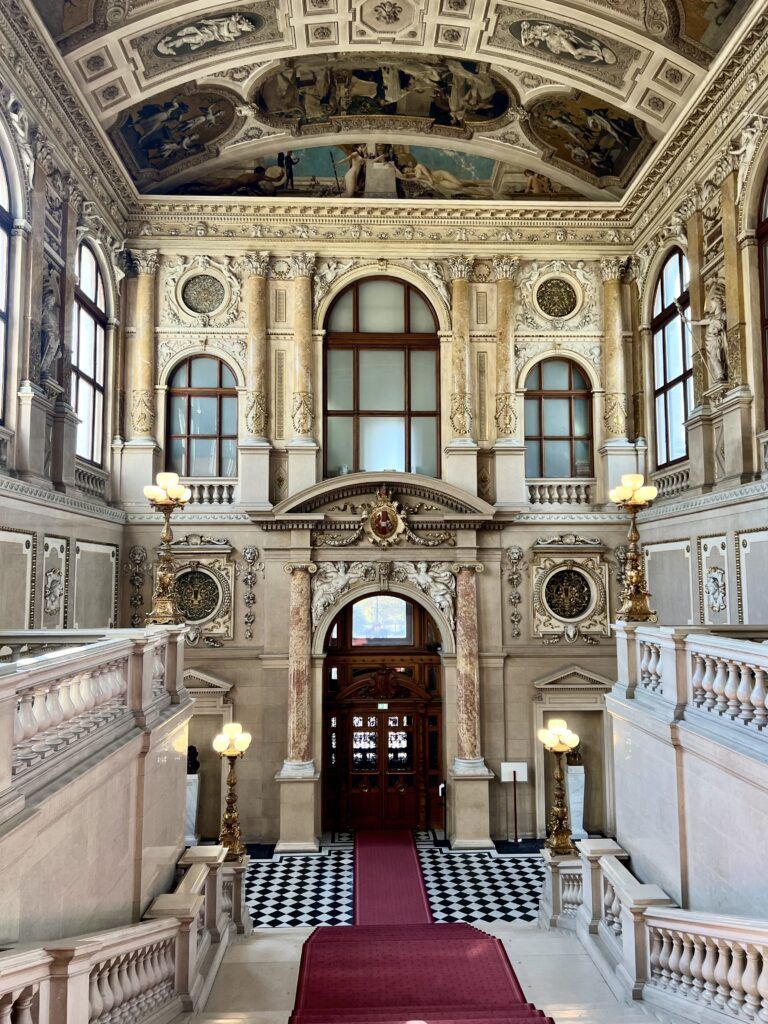
Entrance Halls & Staircases
The most impressive feature of the Burgtheater are the two huge entrance halls on either side of the main auditorium.
The halls feature two grand staircases preserved in their original form. They were built in the Historicist style, popular at the end of the 19th century before the Secession arrived to shake things up.
Until 1918, both staircases were reserved for the imperial family and court. You’ll see busts of famous playwrights and actors on the walls and dramatic gilded lighting.
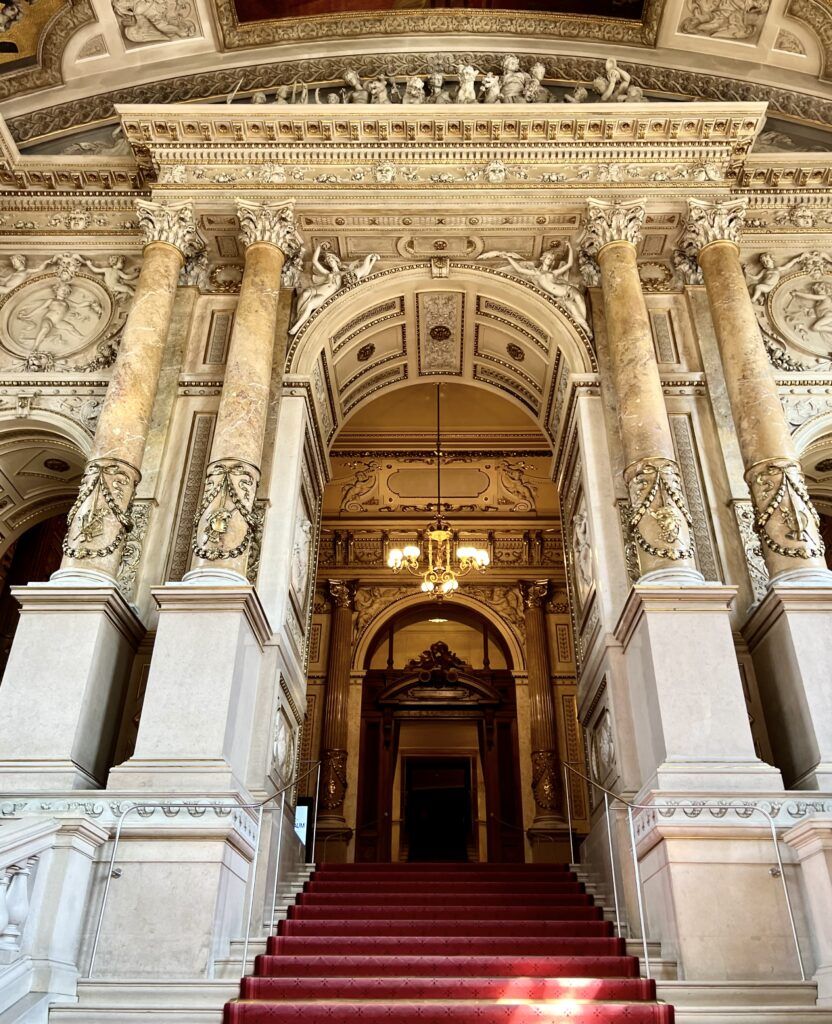
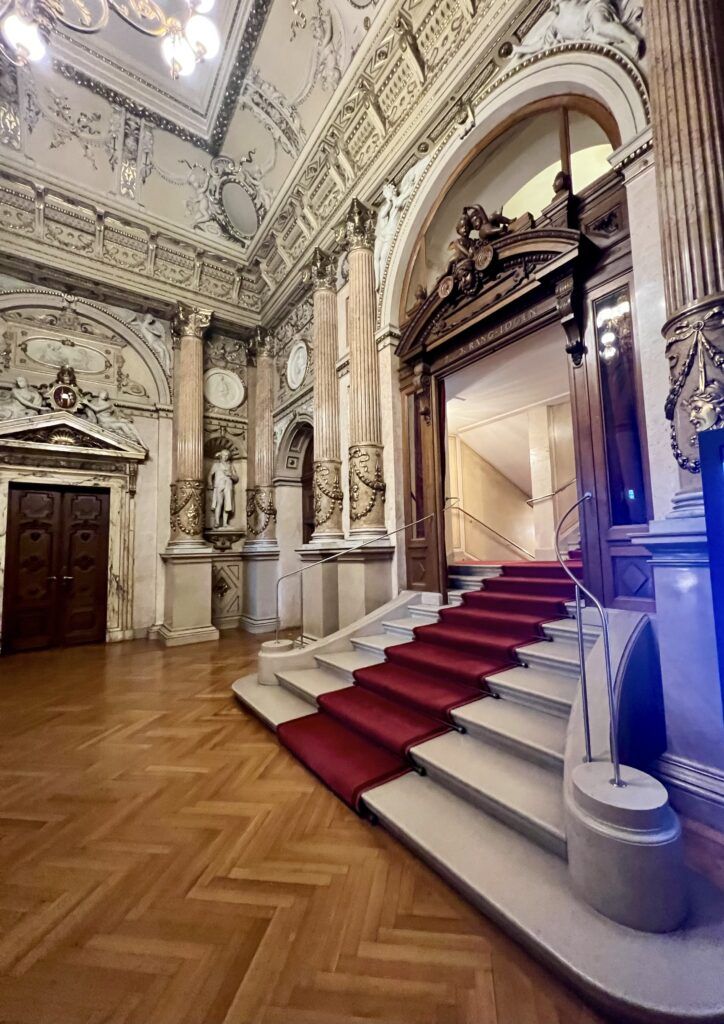
Grand Foyer
The Grand Foyer is an opulent space. It serves as a central gathering area for guests before performances and during intermissions.
The foyer has high ceilings. It’s adorned with elaborate stucco work, gold leaf decorations, parquet floors, and sumptuous materials.
This is where you’ll find the box office (to the right after you enter) and information about current and upcoming productions.
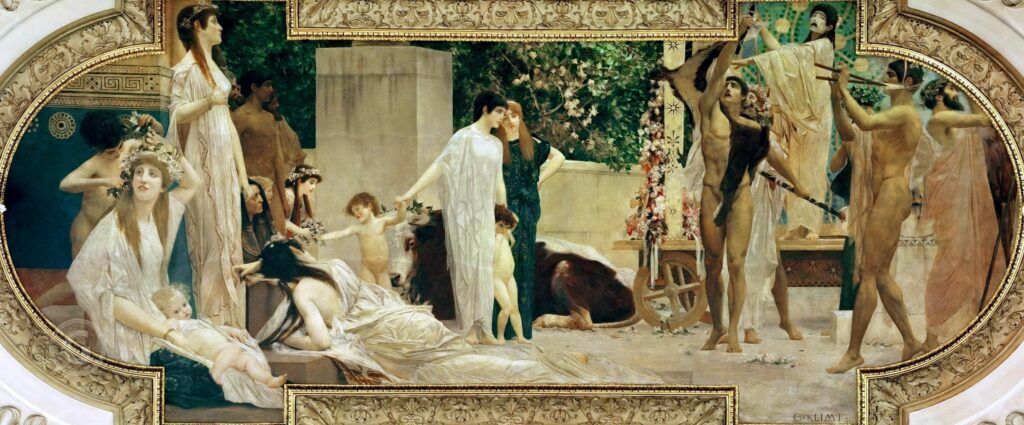
Klimt Frescos
Aside from its plays, the theater is best known for its ceiling frescos by a 24 year old Gustav Klimt.
Other frescos were executed by his two partners, his brother Ernst Klimt and Franz Matsch. Your guide will still identify which ones are by Gustav.
At the time, this was an unbelievably prestigious commission for a young artist. After all, the emperor himself commissioned the artworks and the theater was the meeting place of the aristocracy.
The artists’ compositions are rich in detail, with figures in elaborate costumes and settings that evoke the grandeur of theater.
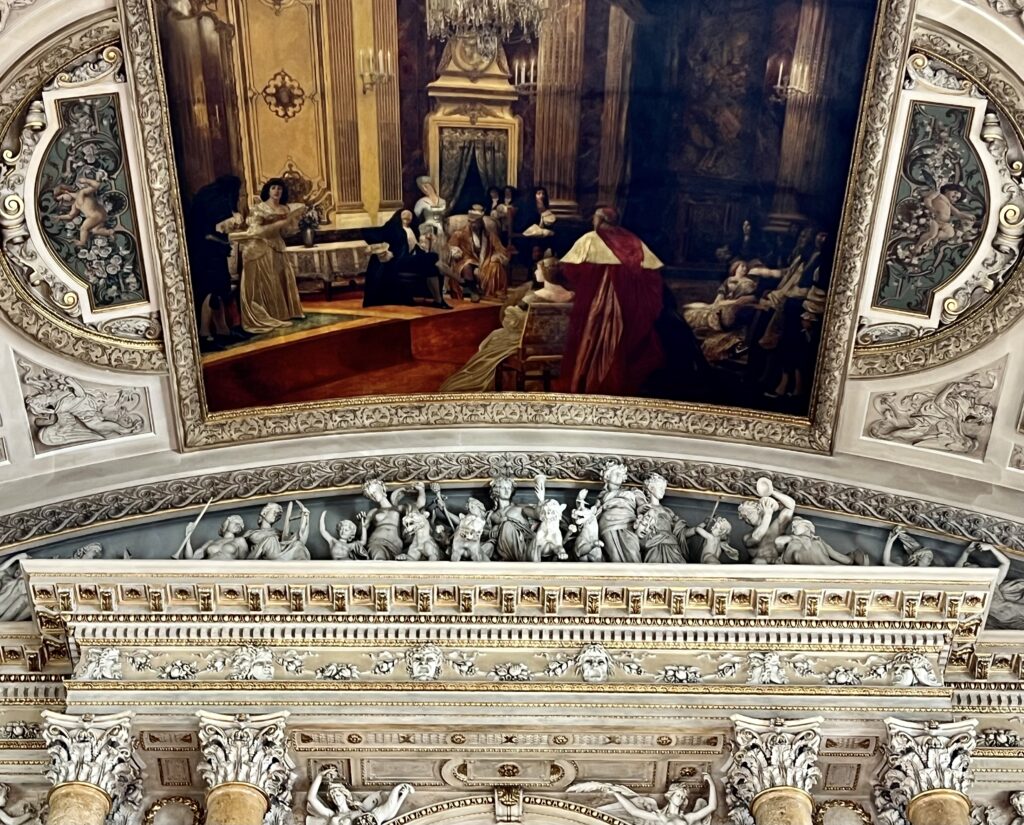
The frescos’ themes relate to the arts and theater history, and depict scenes from ancient Greek dramas and Shakespearean plays.
The Volksgarten staircase showcases theater history. Klimt painted the Thespis Wagon on the ceiling and another piece showing the final scene from Romeo and Juliet.
The Thespis Wagon is from Greek Theater. Thespis is on a carriage, which doubles as a stage. He wears a tragic mask, arms spread in a grand gesture and is surrounded by spectators.
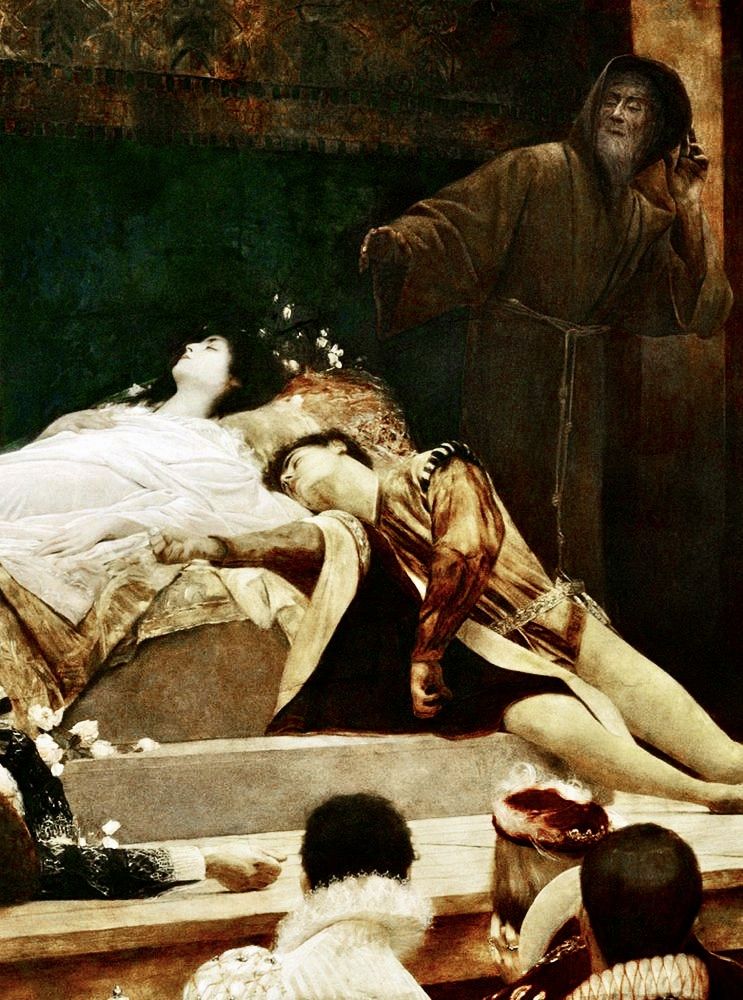
The Romeo and Juliet fresco was a favorite of mine. It’s set inside London’s Globe Theater.
You’ll see the final dramatic scene between the star-cross lovers — when a suicidal Romeo finds that Juliet is dead and collapses on her.
The female figure immediately on the right is reputedly a depiction of Elizabeth I of England.
Portraits of the three artists appear in audience on the far right. One is the only known portrait of Gustav Klimt. He’s the one with dramatic white ruff. Ernst is shown in a red jacket and Matsch in a turban-like black hat.
Fun Fact: Klimt never painted self portraits, unlike many other artists. He claimed he was “less interested in myself as a subject for painting than I am in other people, above all women.”
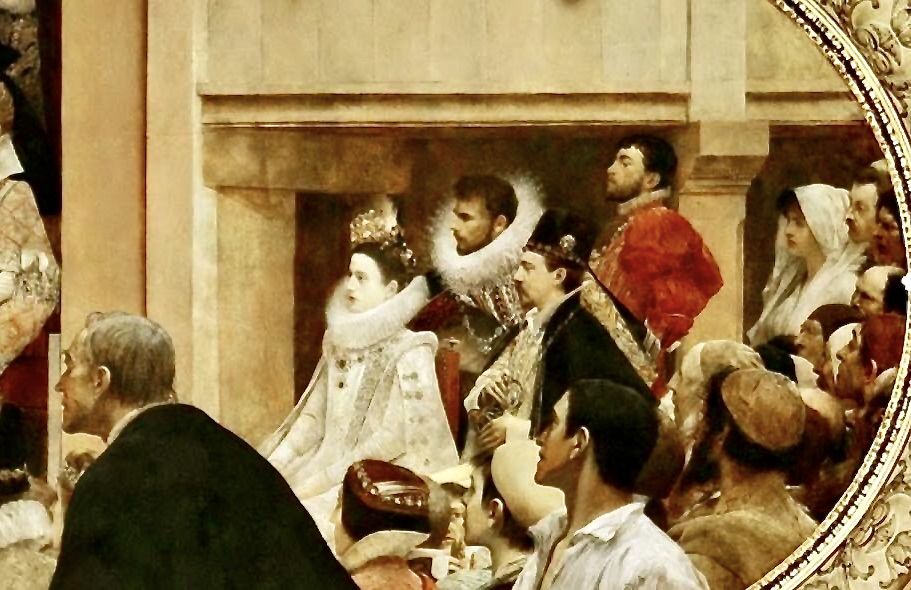
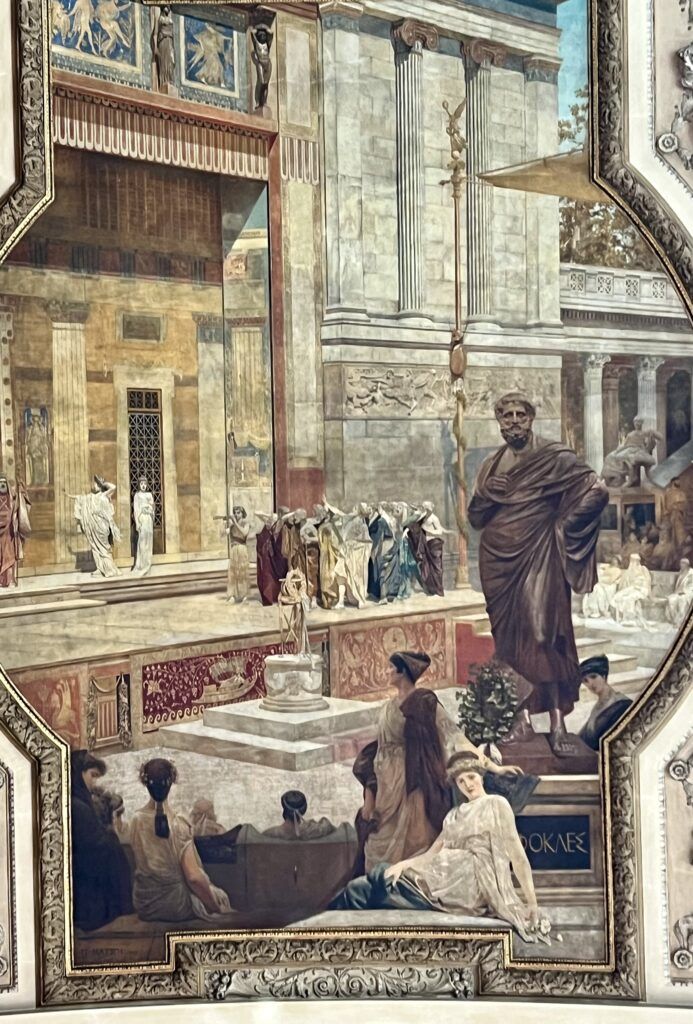
There’s also a depiction of the Dionysus Theater in Athens by Franz Matsch. The central panel is a scene from Siophocles’ Antigone. On set is a rather commanding statue of Sophocles himself.
There’s also a scene from Moliere’s La Malade Imaginaire by Ernst Klimt.
On the staircase on the Landtmann side, the theme shifts to improvisation and folk theater.
It starts with Matsch’s Ancient Improviser. A toga clad youth is expounding, hands raised, to a nude beauty and other listeners.
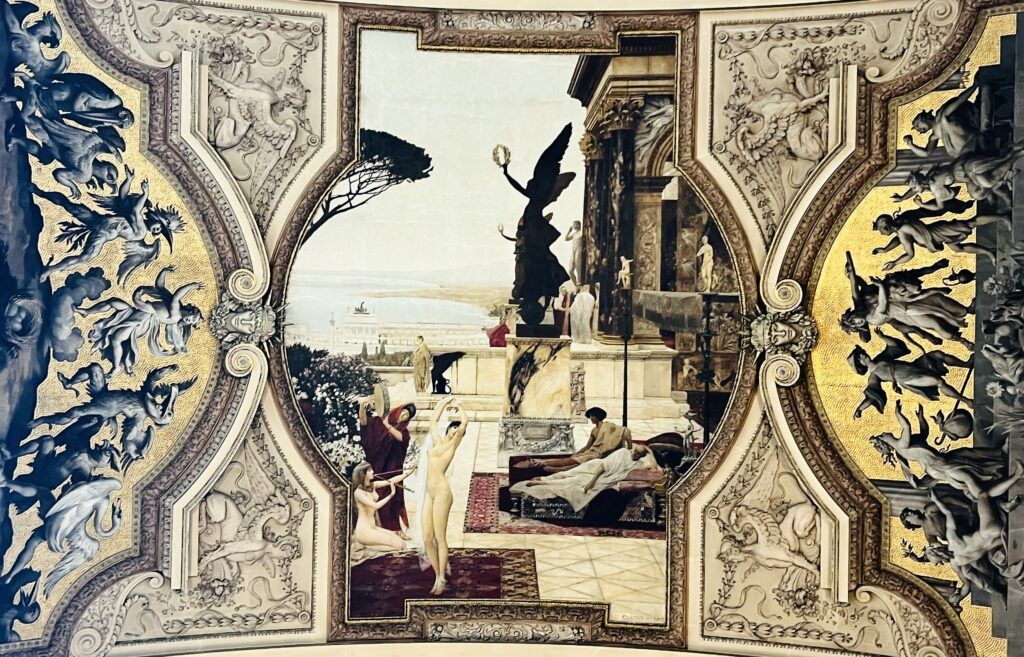
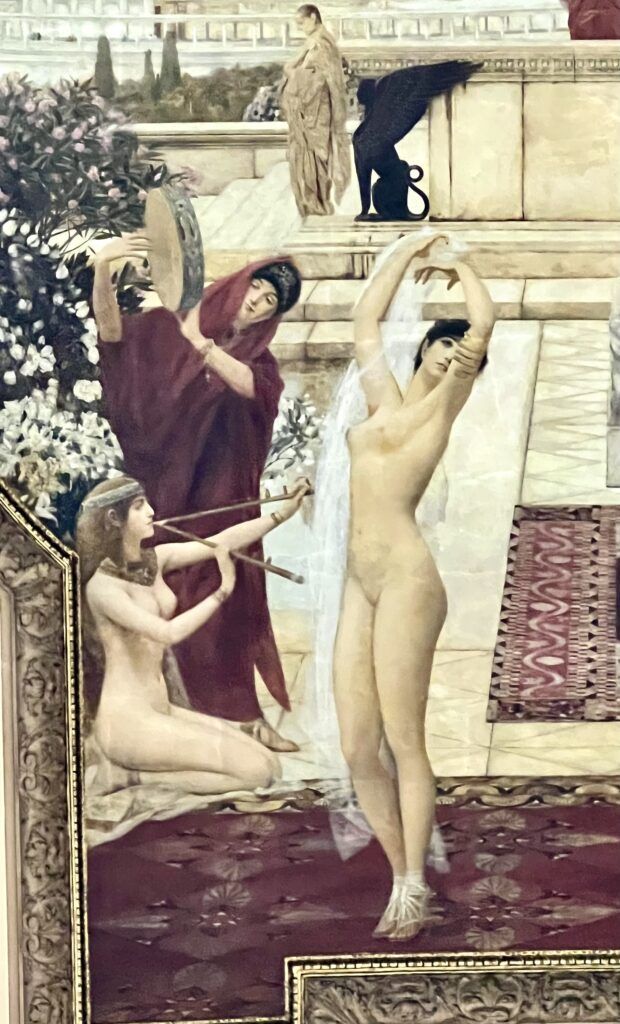
Another beautiful Klimt painting captures a dance scene from the Roman Empire. In the background, you’ll see a view of the Greek Theater in Taormina Sicily as it once looked.
Matsch also portrays a medieval mystery play. And Ernst Klimt illustrates a jester at a fair, intended to poke fun at courtly theater.
In the tympanum over the entrance, there’s an altar for Apollo. It’s filled with statues of German actors and busts of playwrights.
The two grand staircases are crowned with a Dionysian (Bacchus) procession, which includes statues of Apollo, Melpomene (tragedy muse), and Thalia (comedy muse). They’re meant to entice people to see a performance.
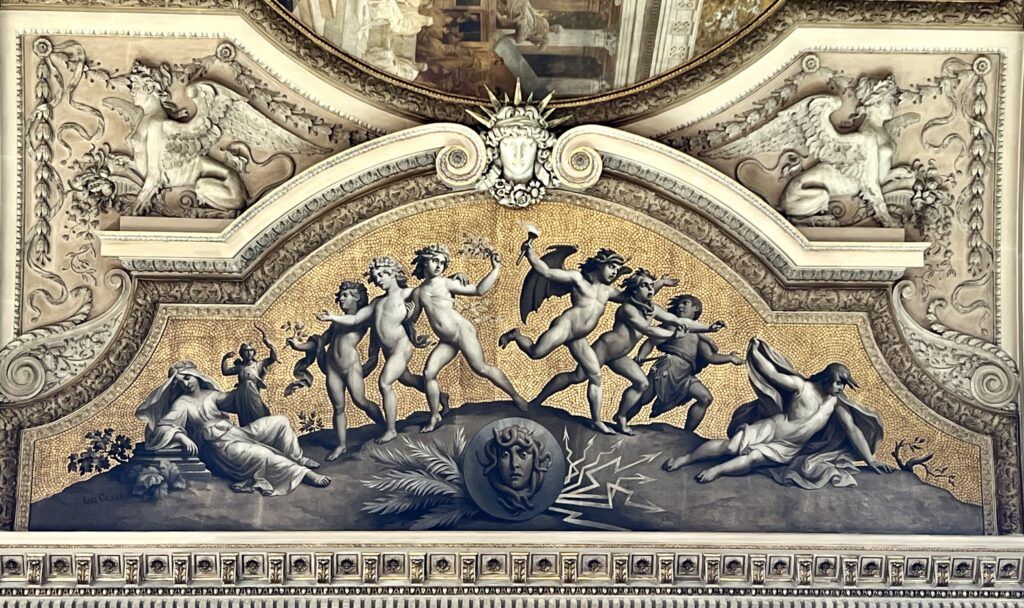
Grisaille Paintings
On the sides of the main ceiling panels, you’ll see paintings in the so-called grisaille technique. They were executed by Carl Joseph Geiger.
Grisaille involves painting entirely in shades of gray in imitation of sculpture. Geier’s works are surrounded by beautiful gold mosaics.
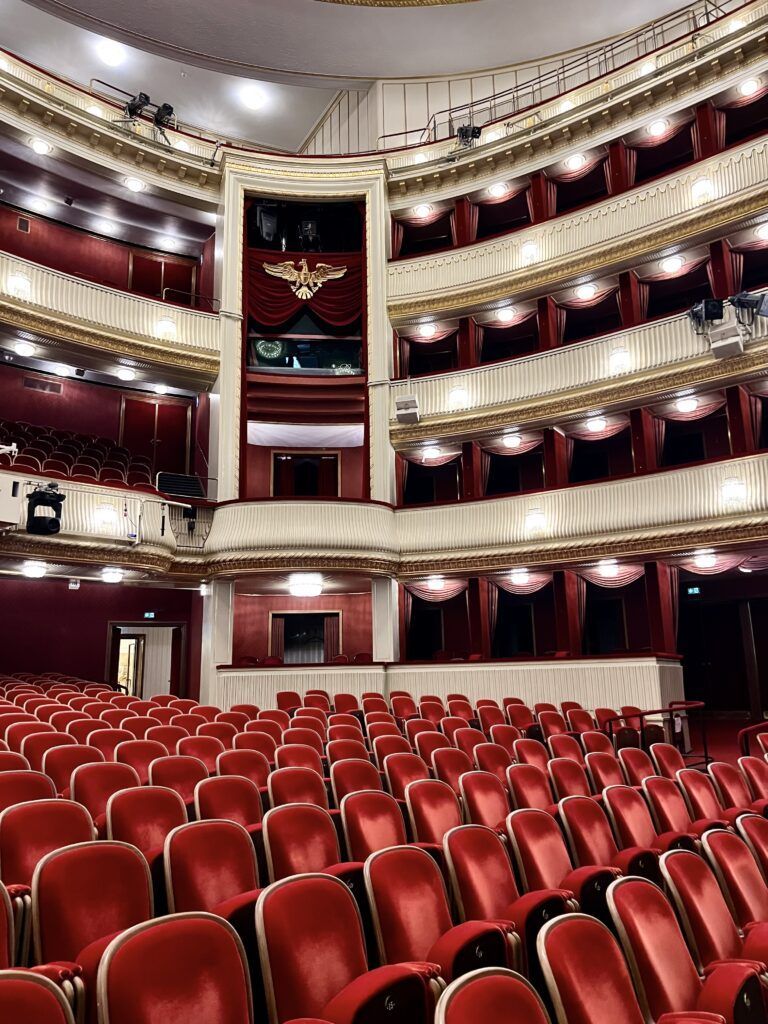
Auditorium/Stage
The auditorium is quite posh. There are four levels of seats, all done up in red velvet. Crystal chandeliers are above.
The page consists of 3 parts: the orchestra pit, the revolving stage, and the backstage area with a lift. On a tour, you’ll see all of these spaces.
Corridor
A corridor wraps around the auditorium. It’s filled with paintings and crystal chandeliers. Fluted marble columns are set into the walls. Windows give you great views of City Hall and other buildings.
The most important members of the company had their portraits taken and they now hang on the walls. The collection was hidden during WWI and conserved.
There is a center buffet that replaced the emperor’s three tea rooms.
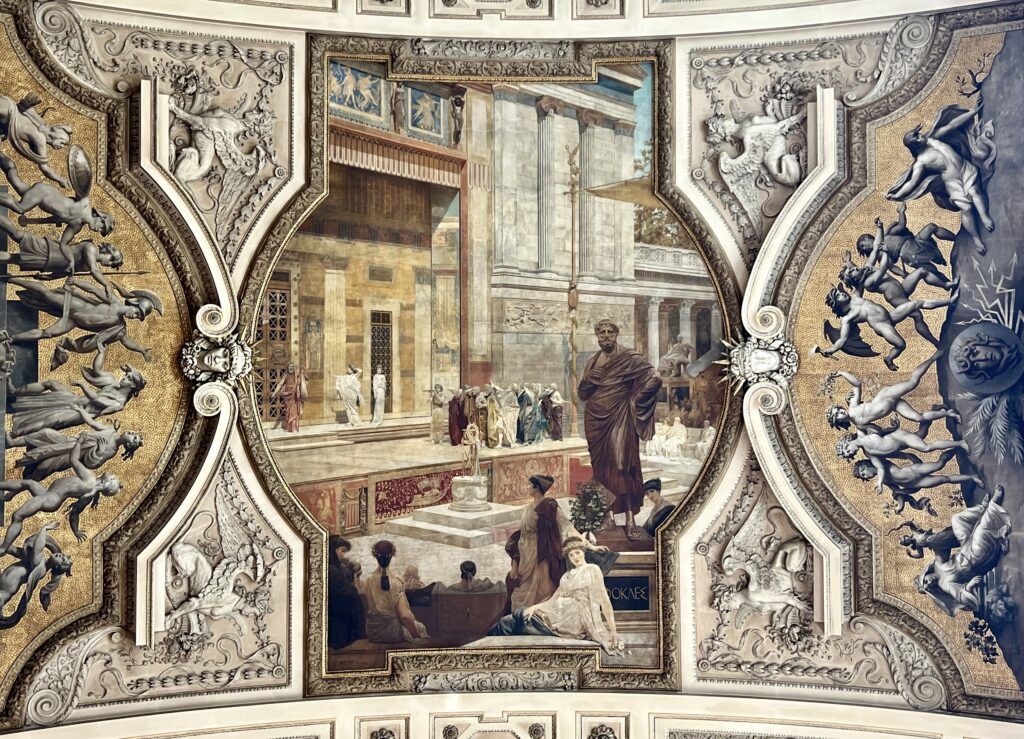
Practical Guide & Tips For The Burgtheater
Address: Universitätsring 2
Ticket: 10 euros. You also get free admission with the Vienna Pass. If you want to see a show, tickets are available online and the box office opens one hour before performance.
Tours:
You can only visit the Burgtheater on a 60-90 minute guided tour at 3:00 pm on Thursday, Friday, Saturday, and Sunday. The tour starts in the box office foyer.
Most of the tours are in German, except in July and August. But I visited in October and our guide gave the tour in both English and German.
If you are taking the German tour, you will be given a sheet with English explanations. You may want to arrive 5-10 minutes early to check in, buy your ticket, and read the pamphlet.
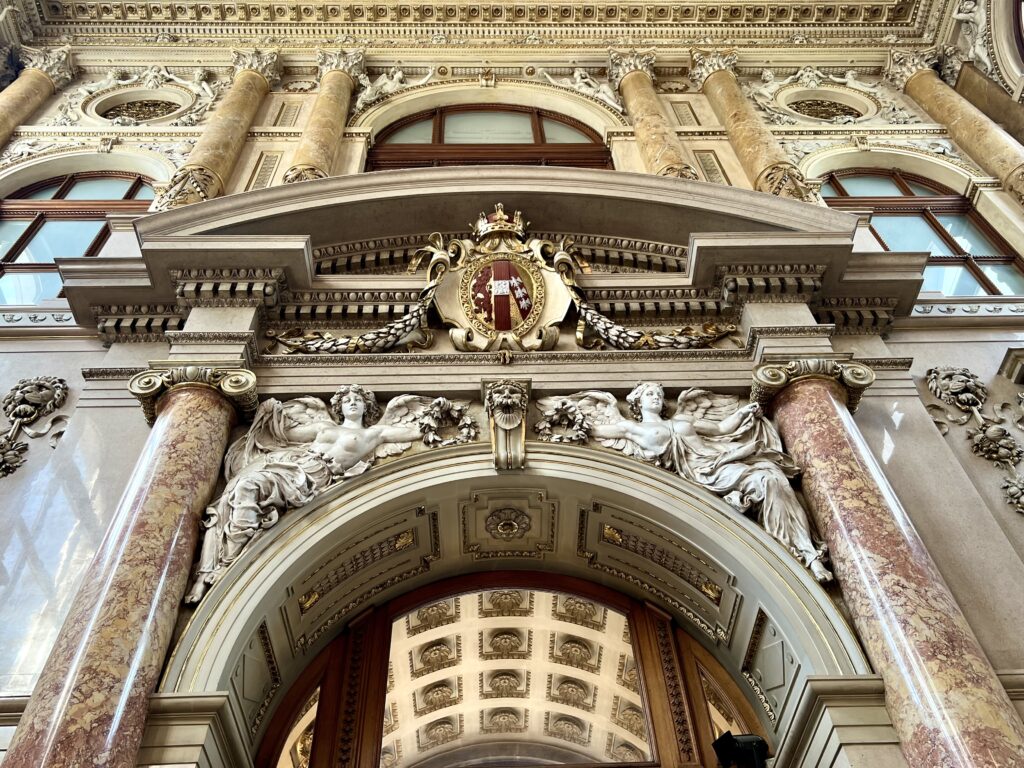
Unless there’s a rehearsal or performance, you’ll get to see the auditorium.
There’s also a special Klimt-themed tour. This one takes your to the “Klimtraum,” where you can see the artist’s full size preparatory drawings or “cartoons” for the frescos. They were found in the theater’s attic in 1999.
What’s On?
The Burgtheater has a diverse repertoire that includes classical works by authors like Shakespeare, Goethe, and Schiller, as well as contemporary plays by modern playwrights.
The theater is also known for its high-quality productions and cutting edge innovative shows.
Pro Tips:
A bookshop within the theater sells plays, literature related to current productions, and theater-themed merchandise.
If you have mini binoculars, you may want to bring them to see the frescos up close.
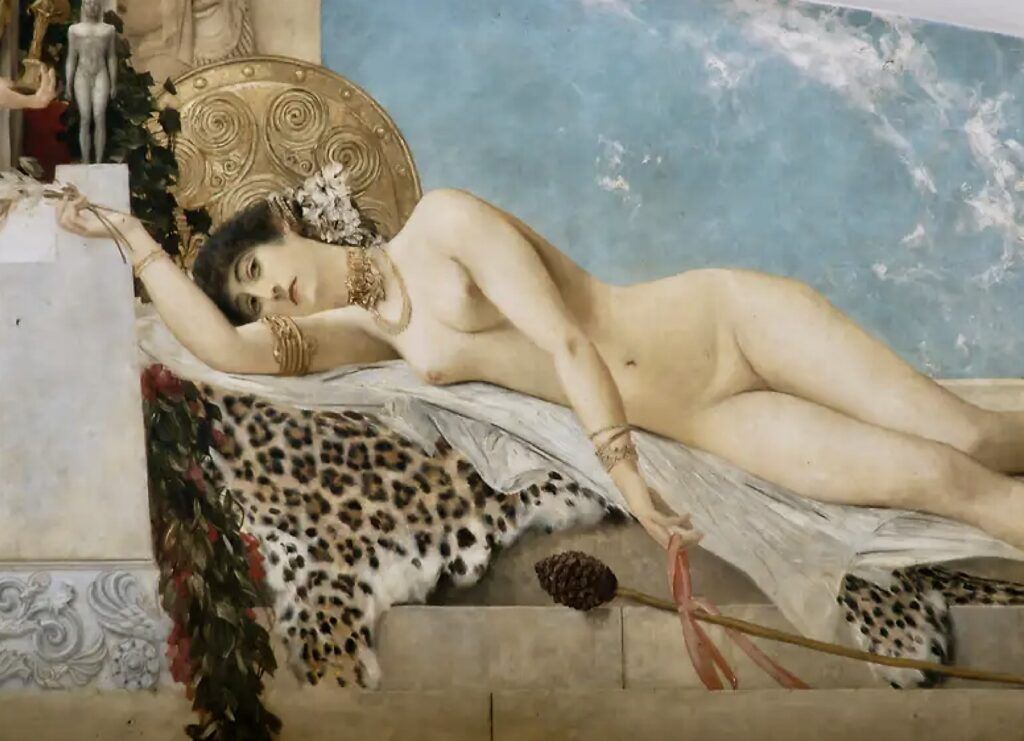
Nearby Attractions
Cafe Landtmann, a traditional Viennese coffee house, is right across the street . If you do the tour at 11:00 am, you can make a reservation for lunch afterward.
The Rathaus (City Hall) is also just a few minutes away. On Monday, Wednesday, and Friday, it has a guided tour at 1:00 pm. So, you could visit the Burgtheater and the Rathaus back to back depending on what day of the week you visit.
The Minorites Church is just a 2 minute walk. It’s a strange and wonderful church of French Gothic design.
I hope you’ve enjoyed my guide to the Burgtheater. You may find these other Vienna travel guides useful:
- 1 Day in Vienna Itinerary
- 3 Days in Vienna Itinerary
- 4 Days in Viena Itinerary
- Best Museums in Vienna
- Tips for Visiting Vienna
- Salzburg day trip from Vienna
- Beautiful Churches in Vienna
- Beethoven Guide To Vienna
- Things To Do in Vienna in Winter
Pin it for later.

